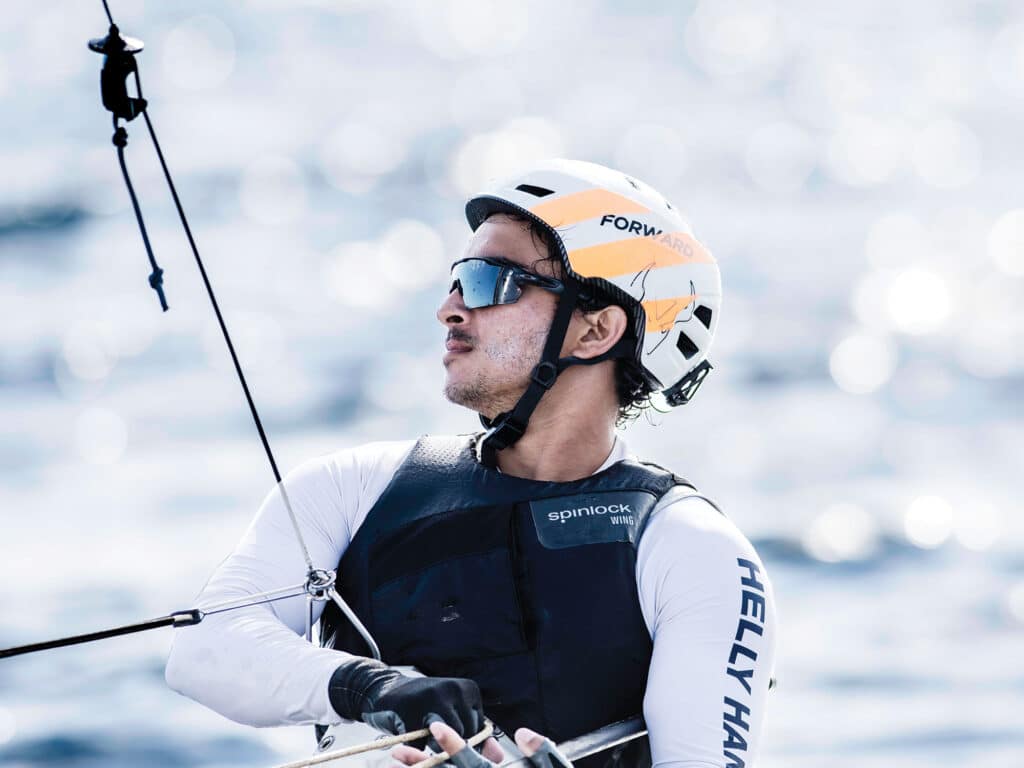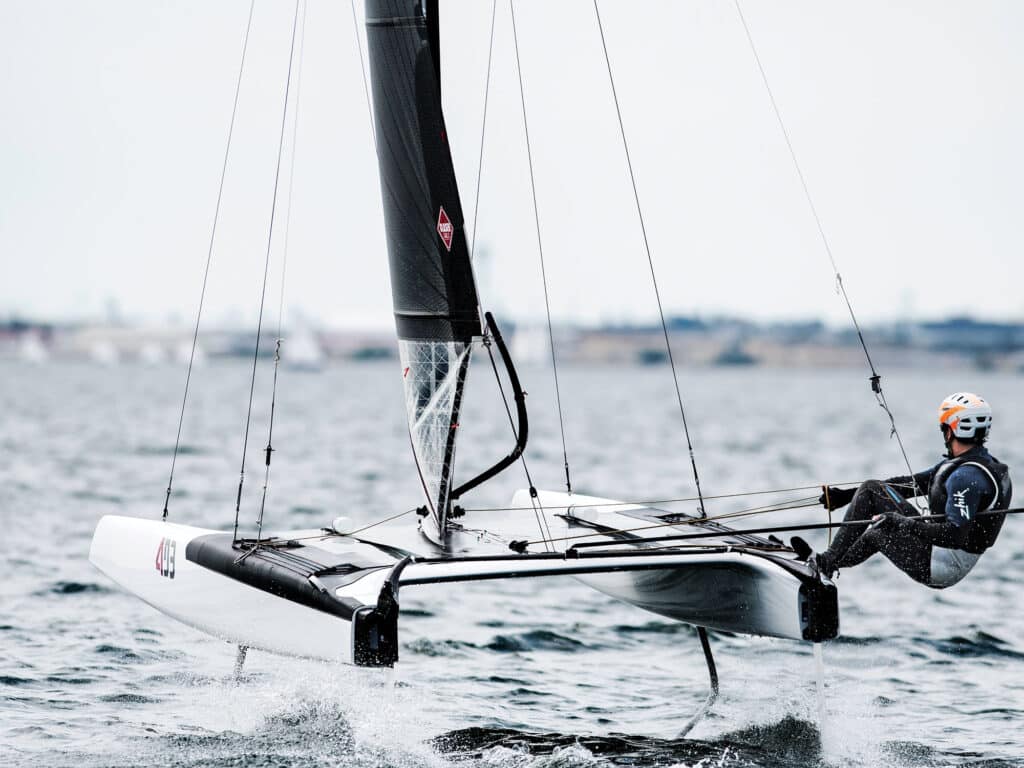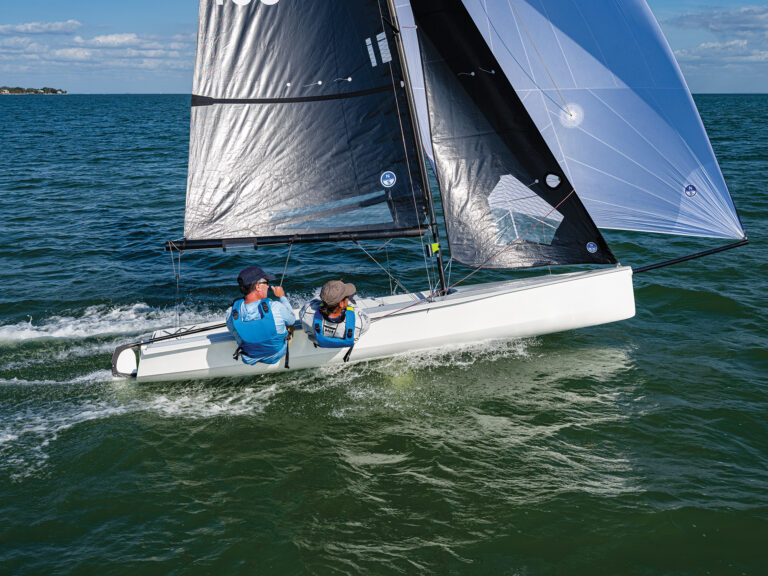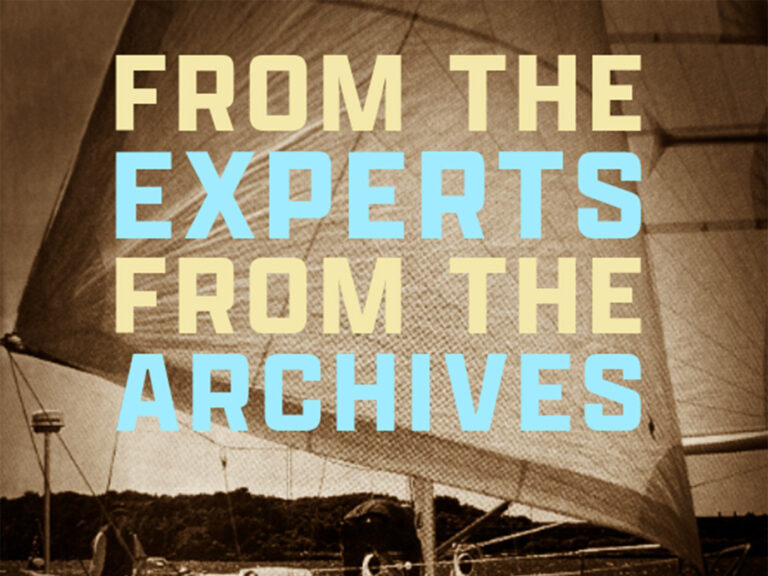
Ravi Parent is sailing at his own pace these days, and the pace is always quick…and calculated. He is as measured as one would expect of a Boston University cum laude mechanical engineer who’s been sailing fast gear since before he had his driver’s permit. His dedication to perfection propelled him to the top of the Worlds for both the A class and Formula 18 catamaran last year. With two world championship titles in hand, he’s the first American sailor to win both in the same year, as well as the F18 Europeans. Cat sailors know that’s a big deal. The A and the 18 require serious talent, commitment and technical savvy. Parent has all three. Being shortlisted as a 2022 Rolex Yachtsman of the Year is a humbling honor, he says, when I catch him driving to the Sarasota Sailing Squadron on a late January afternoon (He would later collect his Rolex Yachtmaster.) It’s also a validation of the work he’s put in and the close-knit cat community that’s supported him along the way. On this particular windless afternoon, he’s headed to where his sailing obsession took hold, for another day of boatwork on his latest challenge—the Moth.
What’s on the work list?
Not much. I’m trying to design a travel bag for the wings so I can fly with them.
How new to the International Moth are you?
I got one at the beginning of last summer (2022). Right after the A Cat Worlds, I sold that boat and got this one because I wanted to take on a new adventure. I’m not done sailing the A Cat by any means, though.
How’s the swimming been?
It’s been a vertical learning curve for the first month, but it’s starting to get a little better and a little more fun every day. The sensations between the A Cat and the Moth are similar; the foiling concept is the same, with the pitch and ride height and all that stuff. The speed and the sail trim are similar, but it’s not trapezing, so your righting moment comes from heel, and the biggest thing I’ve been learning is the effect that heel has on the boat. Jibes have been a bit of a challenge, and the boat I have is the Bieker [model], which has the smaller wings, so…I’ve broken a few tillers while learning to tack, but now I’m a little better at it and saving money.
Where are you on the sailing-versus-boatwork spectrum these days?
Actually, not bad. I’ve been thinking about this recently. The trade-off I’m seeing is that the A is faster to rig—I can go from the parking lot to sailing in like 30 minutes. The daily maintenance is longer, though. With the A, there’s a lot more foil sanding and staying on top of the systems, especially after a windy day. With the Moth, there’s virtually no foil sanding because you barely touch them—they go in and out. Rigging it, however, does take a bit longer. I’m still about an hour from showing up to going sailing, but to be honest, I haven’t broken much. Yesterday, I did about 40 miles in 15 to 24 knots and have no boatwork today.
How do you afford the time and upkeep with all your high-tech, high-demand craft?
I work for Morelli & Melvin as a part-time design engineer, primarily working on power-cat foils. There is some sailboat stuff, but powerboats are easier than sailboats in some regards, so that’s where I’ve started. I’m still getting three to five days of sailing a week, mainly three-hour sessions. I have to be a lot more organized with my time to make sure I’m using every second effectively. Outside of that, I’ve been doing a lot of coaching for the development teams of the Nacra 17 and 49er sailors, and also helping with the US Sailing Team’s equipment tech and testing program.
Take us back to the early days of Ravi the Little Ripper.
I started young in the F16 and the F18s, so it wasn’t quite one-design sailing like traditional junior sailing kids would do, which I now realize is a strength because I was sailing among adults most of the time. Also, the boats were different designs, which got me interested in boat design. At the time, the F18 class had like four different builders, and they were all different. It was a fun learning experience at a young age.
I did Optis and Lasers too, and that was socially driven, as it is with most kids. I wanted to hang out with my friends, but I was also competitive and wanted some independence on the water. I was also small—probably 120 pounds—and I could sail the Radial in Sarasota in light wind, but I’d get my butt kicked in anything over 12 knots, so the doublehanded catamaran was perfect for me. I could sail with one of my bigger friends and be on a more-even playing ground. We had a couple of multihull members at the Squadron who were awesome enough to let a few of us take out their boats. We had a group of six sailors back in 2011, and we all basically set a goal that we wanted to do the multihull championship that summer.
As a lifelong Floridian, how’d you end up college sailing in the cold Northeast?
I did look at a few Florida schools, but I decided to try something different to see if I would like it. Stan Schreyer (Boston University head coach) was awesome to me. He took the time to introduce me to what it would be like going to school there. The allure of college sailing in the Northeast was strong, and it also didn’t hurt that both of my parents went there for their medical school.
What potential do you think Stan saw in you?
I think he saw what other college coaches didn’t realize, and that was my catamaran sailing skills. While other coaches were looking for the traditional youth sailing 420 type, Stan, being a multihull sailor himself, knew that cat sailing forces you to think faster and to have long-term strategic planning. In an FJ, you can do 20 tacks and not lose anything—you might even gain. In cats and skiffs, you’re limited in your boathandling, so you have to be thinking a half a leg ahead. You have to have your plan and fast reaction time. Having those skills coming into college sailing really helped me. I felt if I was being dumb on the racecourse, I could rely on speed, and a lot of that came from cat sailing.
After graduating, you didn’t waste any time jumping into Olympic sailing, did you?
I wanted to dive into it right away. It was near the end of the last quad, so I didn’t have enough time. It was about a year-and-a-half investment. I had done well in the Nacra 17 at the Miami World Cup in my senior year. I had some funding, and all the parts came together to just get into it. That was with Caroline Atwood, and we did a compressed campaign, and like learning the Moth, the curve was vertical. My cat-sailing background helped, but I was functional—not proficient or even good by any means. If I started then with the skills and maturity I have now, I’m sure it would have gone a different way. I’d have to do it again the same way to get to where I am today, but I’m happy with the way things are going now. Learning the boat was a huge part of it. It just requires a lot of hours in the boat because to learn anything mechanical, you just have to do it, but you have to do it efficiently.
I’ve been told that finding the perfect Nacra crew is like speed dating.
Absolutely. It’s a personality match and also a size thing. There might be someone like me who’s more technically savvy, and someone who’s holistic savvy or the right size. There can be a lot of different combinations, but it’s really about bringing out the strengths, and each sailor to make it work. Caroline and I were too small. That was the biggest thing. The Nacra 17, especially now that it’s gone to full foiling upwind, the size had gone up. We were always in the 300 to 310 range, and now it’s more like 315 to 320 combined.
Was it straight to the nine-to-five when that campaign ended?
After we missed selection at the Trials, I got the job with Morelli & Melvin, so it was nice to be able to pay the bills. And I wanted to do something independent of Olympic sailing as well, which is something I suggest to a lot of the Olympic Development sailors I coach. You obviously need to learn your boat, do your diligence and put in the hours, but it’s good to develop something on your own too, especially for drivers who don’t get tired nearly as much as the crews. It’s important to have some sort of singlehanded extracurricular that complements what they’re trying to do. For me, that was the A class. I bought a used one and went straight into it.
Not an easy boat to just
dive into.
It was a steep learning curve for sure. The things I was focusing on and learning in 2020 are so elementary to me now. It was an older boat, and I basically stripped it and started over to get it up to date.
Was it intimidating getting into a class notorious for being an arms-race kind of boat—at least at the top of the class?
A bit, but even now I’m very strict about how I do my budgets. I’m realistic about what I can afford, but I’m also strategic about the equipment I buy and how to do it. I knew, eventually, my strengths in sailing the boat would outweigh a lot of the equipment stuff. From sailing the Nacra 17, the downwind foiling was kind of easy. Fundamentally, I knew what was going to happen. I just need to adapt to having one sail and foils that are a lot more sensitive, and dealing with rudder differential.
To stay at the top of the class, people do end up cycling through boats, but that does not by any means diminish the boat you have. It’s about being realistic. It’s hard in our sport because everyone has different situations, so you can’t compare yourself to anyone else; you can take inspiration and ideas from others, but you really have to scale it to your own life. The biggest thing for me is being able to support myself, covering the basic expenses, and understanding how to have an income and go from there. Figuring out how to make every dollar do as much as it can do. It could be into equipment or coaching, time or convenience. For example, do I rent a slightly more expensive apartment that’s closer to the venue so I can save on time commuting and sail more often—things like that.
What were your expectations going into the A Cat Worlds in Houston?
Looking back, I think I might have been one of if not the most prepared person. I spent the most time at the venue—almost two months—which absolutely provided me an advantage. I didn’t have the latest and greatest equipment, but I had confidence in all the training I’d done in my boat. I knew my boat well and knew what I could do. The more confidence you have in your equipment, the more you can get away with not having the latest and greatest.
What was your approach to training in Houston?
I did a lot of training with Bruce Mahoney. It was about 75 percent with a training partner and 25 percent on my own. I have a list of what I’m working on in any condition, so I’m always prepared for whatever condition I have to make good use of it. With Bruce, we’d do tuning and finish up with some racecourse stuff. But if I was on my own, I’d work on my boathandling for hours, or acceleration, or sail around and study the wind on the bay. Being my first A Cat Worlds, I was being realistic and had no idea what was going to happen.
My focus of the regatta was to continue to have a level head—but my first race was terrible. I rounded the top mark in second and hooked a fish. That day was light-air marginal foiling, so it was really difficult to get the fish off. I rallied for the next race and ended up winning it.
That first race was unusually light air too, and I knew more breeze was coming later in the week. I had been developing a more refined starting technique, which ended up being a bit of a secret weapon. I’d practiced a lot on full-foiling starts, so I knew as soon as the breeze was coming, I’d be able to start 4 knots faster than anyone next to me. That sort of became my strength the rest of the regatta. That made my life easier on the windy days because a couple hundred yards immediate gain off the starting line is a big advantage.

What’s that move called? The Ravi Slingshot?
I learned in Nacra 17 and Olympic sailing that your biggest gains tend to happen when the fleet is all on an even ladder rung, which is certainly off the starting line and up the first upwind leg. That’s when you can pass everyone or be last immediately. So, I knew the starting line would be a critical time and knew the spacing between boats would be good. As the breeze increased, my biggest focus was the starting initiations that require the least investment. By that, I mean I’m trying to accelerate and get on the foil in a thin lane.
How do you practice for that?
Basically, I’d start my watch with a 15-second countdown, do an acceleration, and understand how much time and distance it took me to go from dead stop to full foiling and how much of a lane it used. I could go from zero to full foiling in about three boatlengths, and it was about a boat width of a lane. So, that’s about 12 seconds for acceleration, and 10 seconds on a good day.
It requires being a bit back and envisioning where that clean lane is going to be, where the [windward boat’s] wind shadow is going to be, and whether I can punch through it. The windier it is, the narrower the wind shadow, so you can kind of get through it easier.
Let’s switch over to the F18 Worlds, which you won with crew Severin Gramm, another technical class with some serious talent.
I have been sailing F18s on and off since I was 14. There’s a lot more power in the F18s than the A Cat, so that makes the racing more competitive. It was nice to divide the labor with Severin.
That journey to the F18 Worlds started in 2021. Pete Melvin (the Morelli & Melvin designer for Nacra), he let me take his new boat and rig it. Peter Vink (of Nacra) supplied a boat for the Europeans in Lake Garda, and that was a good result for us, and again that was another regatta that sailed to our strengths. We’re athletic and had the boathandling down, and that paid off because it was a flat-water event and breezy. We knew we could just put the hammer down and out-muscle a lot of people. Severin’s physical and strategic strengths filled in many of the gaps in my own game, and we figured out how to maximize our potential with the short amount of time we had sailing together. The Europeans was Severin’s first time sailing an F18.
You’re 27, a double world champ, and a Yachtsman of the Year nominee. That must make you a pro sailor in demand these days.
I’m technically a Cat 3 because I coach and do receive endorsements, but I’m not paid to go sailing. I’ve never been paid to go sailing. I’d love to be paid, but my philosophy is that I want to do the sailing that I really enjoy. I love the small boats, and I’m open to doing larger boats, but for me that’s not the J/70, which is perfect for what it is and a great class, but I’m a high-performance junkie. I have to sail a boat that goes over 20. That’s my thing. I would love to someday get to SailGP.
Morelli & Melvin is incredibly supportive of the sailing I do, and I could not do it without the flexibility [the owners] give me. Pete has a long history with the A class as a two-time world champion, and I’m trying to beat his record. I still do have the passion for the Nacra 17. I still have the equipment, and feel like I have unfinished business in that class and would like to come back and do my best there. The journey of Olympic-class sailing is incredibly rewarding and just makes you a better sailor. The skills I’m using now, the organization, the planning and the focused training, all came from Olympic sailing.
I don’t come from a sailing family—my dad played soccer and did some local racing and cruising, and my mom was a violinist. But for the most part, I’m really the only sailor in my family, so I take a lot of pride in carving my path in the sport because it’s truly been my own path. I’ve had to figure out all this stuff and learn from people around me. That said, I’m really enjoying everything I’m doing, and I understand sailing is a lifelong career and sport. So, I know eventually my time will come, and I’ll just keep doing what I’m doing.









